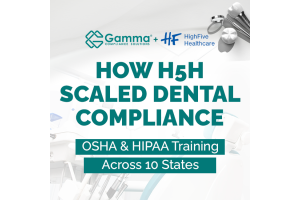How to Reduce Occupational Risks for Expectant Workers in Medical, Dental, and Veterinary Practices
Pregnant employees play an essential role in healthcare settings — from doctors and other licensed providers to dental hygienists, veterinary technicians, nurses, and medical assistants. Because their work may involve exposure to chemicals, biological agents, radiation, or physical stressors, employers have a responsibility to ensure these environments remain safe throughout pregnancy.
While OSHA does not have a single regulation dedicated to pregnancy, existing standards and the General Duty Clause require employers to provide a workplace free from recognized hazards that could cause harm. This article outlines key steps healthcare employers can take to protect pregnant employees safely and compliantly.
Understanding OSHA’s Framework
Under the General Duty Clause (Section 5(a)(1) of the OSH Act), employers must maintain a workplace free from known hazards. Several OSHA standards support this responsibility, including:
- Ionizing Radiation (29 CFR 1910.1096): Limits exposure and requires monitoring through personal dosimeters.
- Bloodborne Pathogens (29 CFR 1910.1030): Protects employees from infectious materials that may present heightened risks during pregnancy.
- Hazard Communication (29 CFR 1910.1200): Ensures awareness of chemical and reproductive hazards identified on Safety Data Sheets (SDS).
- Personal Protective Equipment (29 CFR 1910 Subpart I): Requires appropriate protective gear when exposure cannot be otherwise eliminated.
Common Workplace Risks During Pregnancy
Pregnant employees in healthcare environments may encounter several risk categories:
- Radiation exposure from X-rays and imaging equipment
- Infectious agents such as cytomegalovirus (CMV), parvovirus B19, and toxoplasmosis
- Chemical hazards, including anesthetic gases, sterilants, and certain disinfectants
- Ergonomic stressors from lifting, bending, or long standing periods
- Slip and fall hazards in wet or fast-paced clinical environments
Employers should conduct a hazard assessment to identify these exposures and determine whether modifications or temporary reassignment are necessary.
Radiation Example: X-Ray Duties
Radiation control is one of the most common areas where accommodations may apply. Even though exposure limits are strictly regulated, many pregnant workers prefer to avoid direct participation in radiographic procedures.
- Provide personal dosimetry badges and review readings regularly.
- Ensure protective equipment (lead aprons, thyroid collars, barriers) are in good condition and used correctly.
- Allow voluntary reassignment away from X-ray duties during pregnancy.
- Train staff to step out of the operatory or behind barriers during exposure.
These measures demonstrate both regulatory compliance and a culture of care — supporting employees’ health and peace of mind.
Other Reasonable Modifications
Depending on job duties and practice type, employers may consider:
- Reassigning sterilization or anesthesia-related tasks
- Limiting heavy lifting or patient transfers
- Providing additional rest breaks and hydration access
- Improving ventilation where chemical vapors are used
- Offering flexible scheduling or reduced exposure hours
Accommodations should be handled confidentially and on a voluntary basis, consistent with OSHA safety obligations and EEOC pregnancy accommodation guidance.
Communication and Training
Open communication ensures safety without stigma. Employers should:
- Encourage early disclosure so safety plans can be developed proactively.
- Document identified risks and agreed-upon adjustments.
- Train staff on reading SDSs, recognizing reproductive hazards, and using PPE.
- Reinforce policies that prohibit retaliation or discrimination.
Summary
Protecting pregnant employees is not only a compliance requirement — it’s an ethical commitment to workplace safety and inclusion. By proactively assessing hazards, supporting reassignment requests (such as opting out of X-ray duties), and providing training on exposure control, healthcare employers can maintain compliance while ensuring the well-being of their staff and patients alike.
How Gamma Compliance Solutions Can Help
Gamma Compliance Solutions packages include resources to help you complete your required OSHA documentation correctly and identify where exemptions may apply. Each package provides professionally developed templates, guidance documents, and examples tailored to medical, dental, and veterinary settings — helping your team stay inspection-ready.
You’ll also have direct access to OSHA-Authorized Trainers and compliance experts who can answer questions, clarify complex regulations, and guide you through the documentation process with confidence.
Disclaimer: The information contained in this blog is for general informational purposes only and is not intended as legal, regulatory, compliance or other professional advice. Federal and state laws, rules, and regulations can change, and state laws may vary. As such, we make no warranties or representations about this blog’s information as complete, reliable, or suitable for your specific situation. Your reliance on any information contained in this blog does not establish a professional relationship with us and any such reliance by you is at your own risk. Always consult a qualified compliance professional before making decisions that could affect your compliance obligations. If you need assistance with your compliance responsibilities, please contact us.






